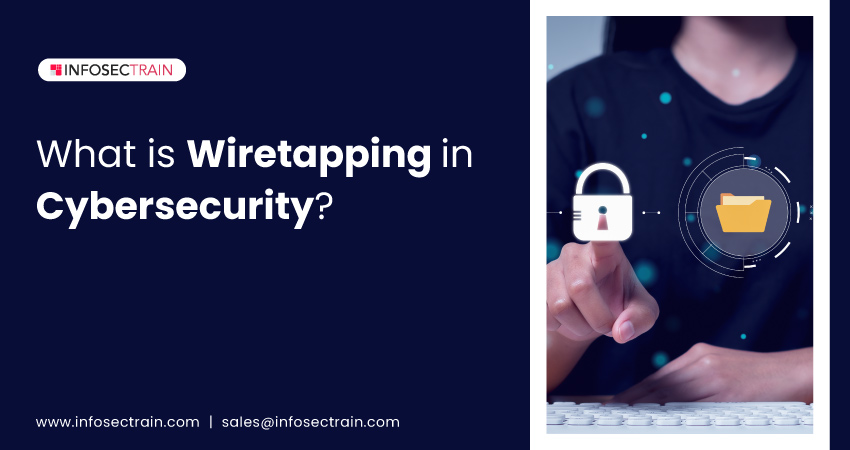What is Wiretapping in Cybersecurity?
Wiretapping in cybersecurity refers to the unauthorized interception or monitoring of electronic communications, typically over wired or wireless networks. It involves the surreptitious access to and capture of data transmitted between two or more parties without their knowledge or authorization. Cybercriminals and malicious actors may use wiretapping techniques to access sensitive information, such as financial data, personal information, trade secrets, or government secrets.

Table of Contents
What is Wiretapping?
How Does Wiretapping Occur?
How to Avoid Wiretapping Risk?
What is Wiretapping?
Wiretapping refers to secretly listening to or intercepting someone’s conversations or communications without their knowledge or permission. It involves intercepting and monitoring telephone calls, digital messages, emails, or other forms of communication by tapping into communication channels to eavesdrop on the conversations or capture the data being transmitted. Wiretapping can be done physically by accessing the communication infrastructure or digitally by exploiting vulnerabilities in networks or devices. It is generally regarded as an invasion of privacy and is often illegal unless authorized by law enforcement with proper legal procedures.
How Does Wiretapping Occur?
Wiretapping can occur in various forms, including physical, network-based, and digital wiretapping.
- Physical Wiretapping: Physical wiretapping involves physically accessing the communication infrastructure, such as telephone lines or network cables, and attaching monitoring devices to intercept and record the transmitted data. This wiretapping is generally more challenging in modern digital networks due to increased security measures and encryption protocols.
- Network-based Wiretapping: Network-based wiretapping takes advantage of vulnerabilities in network infrastructure or devices to intercept and monitor data traffic. This wiretapping can be achieved through techniques such as sniffing, where an attacker captures and analyzes network packets to extract sensitive information. This wiretapping is typically carried out by gaining unauthorized access to network routers, switches, or servers.
- Digital Wiretapping: With the increasing prevalence of digital communication channels, wiretapping has evolved to target digital transmissions such as Voice-over IP (VoIP) calls, instant messaging, emails, or other encrypted communication platforms. In this case, attackers use various techniques like malware, spyware, or advanced hacking methods to gain access to a target’s device and monitor their digital communications.
How to Avoid Wiretapping Risk?
To avoid being the victim of wiretapping, let us discuss some preventive measures. Following are several security measures that can be taken to prevent wiretapping in your organization:
- Encryption: Implement strong encryption protocols to ensure data remains confidential even if intercepted. Encryption converts data into an unreadable form, which can only be decrypted with the appropriate cryptographic keys.
- Secure Communication Channels: Use secure communication protocols, such as SSL/TLS for web browsing or VPNs for remote access, to protect data during transmission and prevent unauthorized interception.
- Network Monitoring: Use network monitoring tools and intrusion detection systems to identify any suspicious network activity, including potential wiretapping attempts.
- Network Segmentation: Divide networks into smaller segments that can help contain wiretapping attempts, making it harder for attackers to access and monitor sensitive data across the entire network.
- Regular Software Updates: Maintain software and devices updated with the latest security patches to mitigate vulnerabilities that could be exploited for wiretapping.
Emerging wiretapping technologies can present several risks and challenges regarding privacy, security, and civil liberties. It is essential to establish robust legal frameworks and safeguards that regulate wiretapping technologies to minimize risks.
How can InfosecTrain help?
If you want to enhance your knowledge, consider taking InfosecTrain‘s Certified Ethical Hacker (CEH) certification training course, which covers the topic of wiretapping. We will provide insights into the methods and techniques used by attackers, helping individuals and organizations understand and detect wiretapping techniques, enabling them to strengthen security measures, protect against unauthorized surveillance, and help them to develop effective countermeasures against wiretapping threats.
TRAINING CALENDAR of Upcoming Batches For CEH v13
| Start Date | End Date | Start - End Time | Batch Type | Training Mode | Batch Status | |
|---|---|---|---|---|---|---|
| 06-Apr-2025 | 24-May-2025 | 09:00 - 13:00 IST | Weekend | Online | [ Close ] | |
| 26-Apr-2025 | 01-Jun-2025 | 19:00 - 23:00 IST | Weekend | Online | [ Close ] | |
| 11-May-2025 | 28-Jun-2025 | 09:00 - 13:00 IST | Weekend | Online | [ Open ] | |
| 31-May-2025 | 06-Jul-2025 | 19:00 - 23:00 IST | Weekend | Online | [ Open ] |







 1800-843-7890 (India)
1800-843-7890 (India)